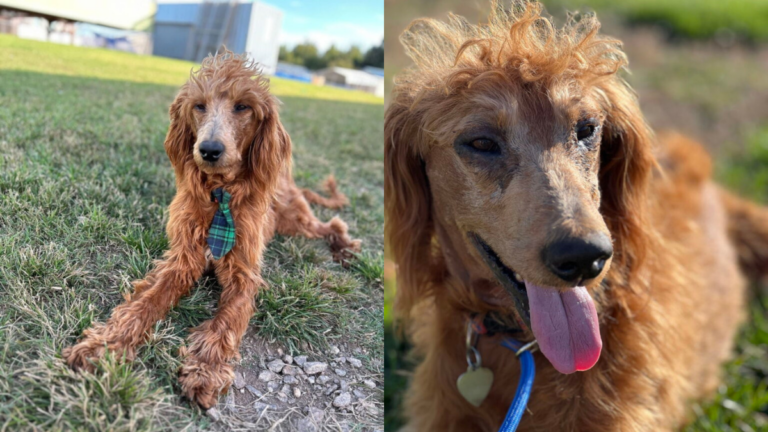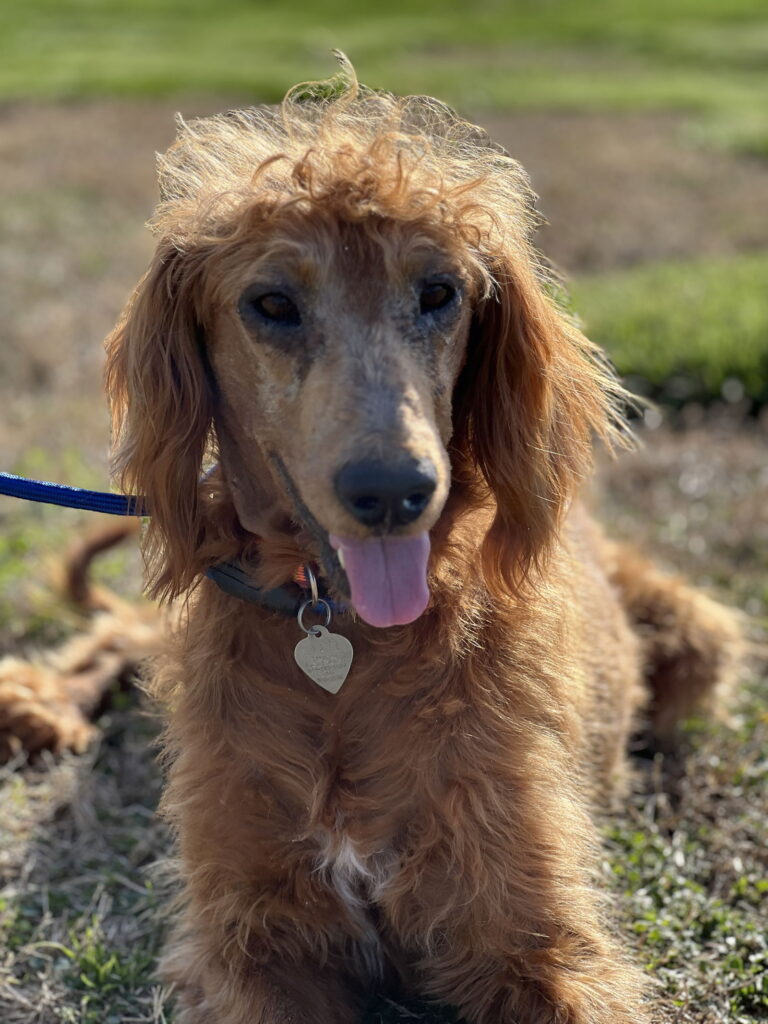Gentle Dog with a Rare Health Condition Awaits a Family Who Will See His Loving Heart
A gentle dog with a perfect disposition and a rare condition is hoping to find his forever family. Hershey, a 4-year-old Irish Setter-Poodle mix with a striking red coat, is currently in the care of a rescue in South Carolina, awaiting a loving home.

Hershey’s search for a second chance at happiness began when he was surrendered to a rural shelter for reasons unknown, leaving his past a mystery. Now, this affectionate pup is looking for a family who will embrace both his sweet nature and his unique needs.
Suffering From Auto-Immune Skin Disorder
When Hershey arrived at the shelter, the staff discovered that the dog has an autoimmune disease that affects his hair growth. Wishing for a loving home for the sweet dog despite his condition, they reached out to the Carolina Poodle Rescue, who agreed to help.

As it turns out, Hershey has sebaceous adenitis, a skin condition causing his hair to thin out and eventually leading to complete hair loss. To manage this, the dog gets a regular bath at his foster home in Pacolet, South Carolina.
Hershey’s condition can become an obstacle in finding his happy ending because he needs a home where his unique looks are appreciated and his needs are taken care of. The dog has been with the rescue for almost a year and thus, their staff is desperately trying to place him in the perfect home where he will get all the love he deserves.
Can You Be Hershey’s Happy Ending?

A young dog with an older dog’s temperament, Hershey is the perfect dog for homes with medium-energy environments. He may be big in size, but he is the calmest soul you have ever encountered.
Lover of long walks, this dog doesn’t need a marathon runner to fulfill his activity needs. He is more than happy to relax with his parent and cuddle.
Additionally, Hershey can thrive in homes with children aged 8 and older and gets along well with small dogs and cats. However, he would do best as the only pet in the household.
Hence, if you think you and Hershey are a perfect match, you must meet him at his foster home. With an adoption fee of just $1, anybody can have a chance to shower this priceless dog with love.

Sebaceous Adenitis In Dogs
After knowing about Hershey, it’s natural to wonder about his condition, sebaceous adenitis. What is it? Let’s find out.
“Sebaceous adenitis is an immune-mediated disorder in which an inflammatory process is directed against the sebaceous glands in the skin,” as stated by veterinarians Dr. Malcolm Weir and Dr. Robin Downing. Located alongside hair follicles, the sebaceous glands produce sebum, a natural oil that moisturizes and protects the skin, keeping it supple, while also conditioning the hair coat to maintain its softness.
Sebaceous adenitis manifests in two distinct forms: one typically impacting short-haired breeds and another affecting long-haired breeds. Certain dog breeds are more likely to have this skin disease than others. For instance, cases of sebaceous adenitis in Poodles, in Akitas, in Samoyeds, and in Vizlas are much more common.

Symptoms of Sebaceous Adenitis
Sebaceous adenitis dogs exhibit distinct symptoms in long-haired and short-haired breeds.
Long Haired Breeds
You are likely to see these symptoms in sebaceous adenitis pictures in breeds like Standard Poodle, Akita, German Shepherd, Havanese, and Samoyed:
- Symmetrical hair loss
- Dull, brittle coat
- Persistent white skin scales
- Matted hair tufts
- Lesions on the head and spine
Severe cases (common in Akitas): itching, bacterial infections, lethargy, fever, and weight loss
Short-Haired Breeds
Breeds like Vizsla, Miniature Pinscher, Beagle, and Dachshund show these symptoms:
- Patchy, moth-eaten hair loss
- Mild skin scaling
- Lesions on the head, ears, and torso
- Potential scarring
- Rarely develops bacterial infections
Diagnosis of Sebaceous Adenitis

Dr. Melissa Boldan, a veterinarian at PetMD, says, “Sebaceous adenitis is diagnosed with results of a skin biopsy, obtained surgically with your dog under anesthesia. If this test is recommended, withhold food and water beginning the midnight before your pet goes in for their biopsy.”
Before proceeding to a skin biopsy, your veterinarian will conduct a series of tests to rule out conditions similar to canine sebaceous adenitis. They are as follows:
- Physical examination
- Skin scrapes
- Hair plucking for microscopic analysis (trichoscopy)
- Fungal or bacterial skin cultures (to detect secondary infections)
- Bloodwork (to screen for underlying hypothyroidism)
When consulting with your veterinarian about suspected sebaceous adenitis, it’s essential to share vital information about your dog’s health history. Please inform your veterinarian if your dog is experiencing itching or discomfort, as this can indicate secondary skin infections or allergies.
Sebaceous Adenitis Treatment
While sebaceous adenitis is incurable, effective management is possible with lifelong therapy. A tailored combination of topical products, oral supplements, and medications can help alleviate symptoms. Here are some of the options for treatment of sebaceous adenitis that your veterinarian may prescribe:
Topical Therapy
Initial management often begins with:
- Medicated shampoos (e.g., Virbac Keratolux) containing sulfur and/or salicylic acid
- Daily sprays of dilute propylene glycol
- Weekly baby oil soaks

Oral Supplements and Medications
Recommended oral supplements include:
- Omega fatty acids
- Vitamin A
- Niacinamide (a form of vitamin B)
In more severe cases, oral medications may be prescribed:
- Antibiotics or antifungal medications for secondary infections
- Doxycycline to support immune system response (though chronic use risks antibiotic resistance)
- Cyclosporine products (e.g., Atopica) to regulate immune system attack on sebaceous glands (may promote gland regeneration)
- Steroids or retinoids (require frequent follow-up visits to monitor response and potential side effects)
Your veterinarian will work with you to develop a personalized treatment plan, monitoring your dog’s progress and adjusting therapies as needed.
Recovery and Management of Sebaceous Adenitis in Dogs
Managing sebaceous adenitis requires ongoing veterinary care, particularly if your dog is prescribed long-term medication. Regular check-ups with your veterinarian will ensure the effectiveness of treatment and monitor potential side effects.
Monitoring Medication Side Effects
Certain medications require closer monitoring:
- Dogs on isotretinoin need bi-weekly liver value checks initially, along with Schirmer Tear Tests to ensure normal tear production, as this medication can affect tear production.
- Long-term steroid or cyclosporine treatment necessitates regular bloodwork to verify liver and kidney function.
Maintenance and Hygiene
A crucial aspect of managing sebaceous adenitis is maintaining skin health through regular bathing with medicated shampoo or baby oil for the remainder of your dog’s life.
Frequently Asked Questions (FAQs)
What is sebaceous adenitis in dogs?
Sebaceous adenitis damages oil glands in dogs, reducing sebum production. The clinical signs of sebaceous adenitis include dry, irritated skin, hair loss, scaling, dandruff, and secondary infections, ultimately compromising a dog’s overall skin and coat health and well-being.
What is sebaceous adenitis natural treatment?
According to the National Library of Medicine, Baby oil soaks are a holistic treatment for sebaceous adenitis. Apply baby oil or a 1:1 oil-water dilution to the coat, massage gently, and leave on for 1-6 hours to soothe and penetrate the skin. Following this, you can bathe the dog with a shampoo to eliminate extra oil from the coat.
How to prevent sebaceous adenitis?
Sebaceous adenitis cannot be prevented due to its inherited nature. The only control measure is avoiding breeding affected dogs. However, since the disease is recessive, it may bypass a generation, making it challenging to identify carriers. Responsible breeding practices are crucial to minimize the risk of passing it to offspring.
Can dogs die from sebaceous adenitis?
While sebaceous adenitis is not a fatal disease in itself, as per Dr. Rosanna Marsella, it is a progressive condition and sometimes, it can lead to secondary bacterial infections and ulcers. These are “severe enough to be the cause of euthanasia.”












